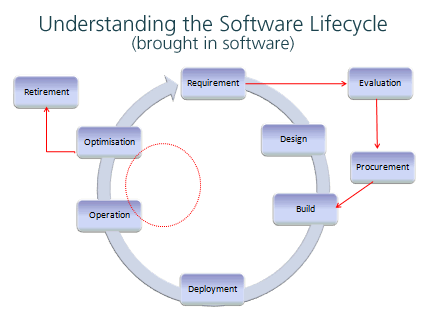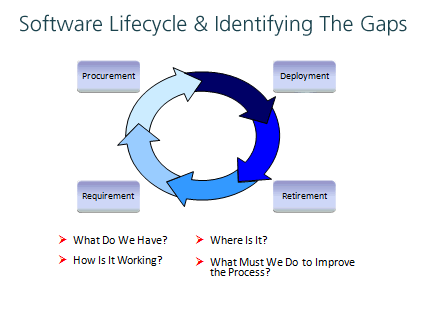ITIL & Software Asset Management
When looking at the ITIL guidance and ISO standard for Software Asset Management, SAM initially appears to be a complex task, touching many parts of IT and also business management. It is not complex when it is broken down into its constituent parts, but can be difficult to manage in it's entirety. The entire standard is not appropriate for every organisation.
SAM is far more effective once you understand your organisation's needs enabling you to tailor a management process that is focused on those key areas.
There are four components to SAM
- Lifecycle Processes
- Controls
- SAM Process
- SAM Policy

The software lifecycle follows the life of software within an organisation from purchase through to retirement .To an extent these processes will already exist within every organisation where software operates. Effective SAM simply ensures these processes interact together in a proper way so that information flows correctly across an organisation to help improve decision making to achieve the most efficient use of purchased assets and controlled expenditure.

Lifecycle Processes
There are processes associated with each of the four stages of the software lifecycle, for example, procurement processes administer the purchase of software from suppliers and the maintenance of license records thereafter; Deployment involves the installation of software on your network; Operation will cover support of software and Retirement processes ensure software and records are dealt with appropriately when they are no longer needed.
Controls
Controls ensure that your Lifecycle Processes function within the required guidelines - there is a layer of controls for each set of processes. An example would be when buying software it is essential to ensure that you are buying from a reputable source, otherwise there is a risk that the goods could be counterfeit.
SAM Process
To ensure the Lifecycle Processes and Controls properly relate with one another, we then add a layer of SAM Process that creates and maintains SAM information by connecting all the individual parts together.
SAM Policies
It is important that every employee agrees to treat IT assets in the correct way. A SAM policy does not have to be onerous, but it should be there to mitigate the risk of misuse of software, such as illegal downloads or purchasing licenses in an adhoc manner.
Process Maturity
For each lifecycle and SAM process, it is necessary to measure process maturity to understand how your SAM practice can develop and mature to drive greater efficiencies and cost savings.
Where processes are 'immature', for example, where no management exists, the risk of non-compliance and over spending often dominates. As an organisation's SAM processes mature, it is possible to eliminate risks and create financial efficiency.
Using the SAM Optimisation Model assessment, we can help you understand your current SAM maturity and identify a roadmap for improvement. The SAM Optimisation Model enables you to identify quick wins as well as longer terms goals and helps you to build a business case to support investment in SAM.
We can help you conduct a formal review of your estate, which will breakdown the 4 lifecycle stages plus the SAM process and the risks and benefits associated with each one. We can also help you evaluate your SAM maturity and work with you to improve your approach to SAM.
If you would like further information please contact us.

